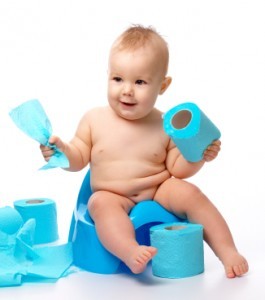 Your child has shown signs that he is ready, you’ve got everything ready to go, and you have started the process of toilet training with your toddler. Now what? How long will this take?
Your child has shown signs that he is ready, you’ve got everything ready to go, and you have started the process of toilet training with your toddler. Now what? How long will this take?
Toilet training can take days or months. Some children progress relatively smoothly, while others lose interest and seem to go backwards. Have patience, every child without significant psychological or medical issues eventually achieves toilet training. Rushing our children through this process will only hamper our efforts as no-one likes to go to the toilet when stressed out!!
Here are a few tips to help keep the toileting process as smooth as possible:
- Dress your child in easy to remove clothing.
- Periodically remind your child about checking if they need the toilet. Kids can get very involved in their activities and play and not notice the signs their body is giving them.
- Be prepared to do quick dashes to toilets. Kids often let us know they need to go “NOW”. Make yourself aware of where public toilets are when out and about. Be prepared to leave the shopping cart where it is and go.
- Have changes of clothes on hand – at home, daycare, grandmas, playgroup, in the car…Remember to replace them for next time.
- Watch your child’s diet – keep up fibre and water to avoid constipation and other discomforts.
- Have little board books in the toilet room or put colourful posters on the walls so your child has something to do when waiting on the toilet. Make sure the books stay in the toilet room so they are a novelty to look at (and you don’t have to go looking for them each time). These distractions can be particularly helpful for children who are afraid to sit on the toilet.
Here are a few more important tips and ideas to be mindful of when helping your child to toilet train:
- Only sit your child on the toilet or potty for a few minutes at a time. If they have not done anything by then, take them off. Longer only seems like a punishment.
- Use lots of praise and encouragement for toileting efforts. Material rewards, such as stickers or a small toy, can be useful for some children also.
- Help you child when they are finished on the toilet or potty by wiping their bottom. Wiping back to front, especially for little girls, will teach your child the most hygienic method. Little boys can be shown how to gently shake their penis after weeing to remove excess drops.
- Help your child to wash his hands after going to the toilet or potty. Doing this from the start assists your child to remember it as part of their toileting routine.
- Be aware that night-time toilet training takes longer than day-time achievement. Many children are 3-4 years old before they are dry at night, and it is not uncommon for children to continue to have wet nights up to seven years old. Keep nappies or night pants available and reassure your child that you will help them if they wake at night and need the toilet.
Children achieve toilet training at their own pace. You can help them in this process by being positive, recognising their efforts, and having patience – please remember that it is a marathon and not a sprint. If you set your expectations to be that your child will take many months to toilet train, with slow steps forward and some steps back at times, you will be more realistic and patient with the process. Whereas if you expect the process to be completed in a couple of weeks, you and your child will become stressed and frustrated with the process and it may well stop progress altogether. If you have concerns about your child’s toileting, or other developmental or psychological issues, please make contact with use and you can speak with one of your psychologists.
To Know more, you can visit : Child Psychologist Brisbane

